Posted by Elena del Valle on February 3, 2025
This article and interview were created without AI-assisted technologies.

Hernan Tagliani, president, The Group Advertising
Photo: Hernan Tagliani
A podcast interview with Hernan Tagliani, president, The Group Advertising, is available in the Podcast Section of Hispanic Marketing and Public Relations, HispanicMPR.com. During the podcast, he discusses multicultural mainstream: the power of Hispanics in consumer marketing with Elena del Valle, host of the HispanicMPR.com podcast.
According to his bio Hernan, also founder of The Group Advertising, is a leading multicultural marketing expert and marketer. His articles have been published in The Business Journals, the Houston Chronicle, Adweek, Entrepreneur Magazine, as well as Forbes (Central America edition).
To listen to the interview, scroll down and click on the play button below. It is also possible to listen by looking for “Podcast” then selecting “HMPR Hernan Tagliani” and downloading the MP3 file to your audio player. You can also find it on the RSS feed. To download it, click on the arrow of the recording you wish to copy and save it to disk. The podcast will remain listed in the January 2025 section of the podcast archive.
Posted by Elena del Valle on November 20, 2019
By Gabriela Lechin
Senior vice president
Global Results Communications

Gabriela Lechin, senior vice president, Global Results Communications
Photo: Global Results Communications
Despite accounting for less than 20 percent of the United States population, Hispanics accounted for 82 percent of the United States labor-force growth participation between the years 2010 and 2017. Gross Domestic Product (GDP) among Hispanics in America grew at a faster rate than the overall United States economy during this time, increasing from $1.7 trillion in 2010 to $2.3 trillion in 2017, according to the 2019 LDC U.S. Latino GDP Report by the California Lutheran University, making it the third-highest growth rate among all global economies during that period on a compounded annual basis. Some of the main influences powering this performance are Hispanics healthy growth in population, their increasing consumer spending and high labor-force participation. According to the report, the financial contribution of the Hispanic community in America will become progressively significant in the upcoming years of the country’s economy.
Click to read the entire Guest Article by Gabriela Lechin: Finding the silver lining in cultural appropriation
Posted by Elena del Valle on June 21, 2017

Yann Guillet, marketing director, Prototypo
Photo: Prototypo
Following a Kickstarter campaign in 2014 that gave the concept worldwide exposure and a following, in October 2015 Yannick Mathey established Prototypo (111, Boulevard de la Croix-Rousse, 69004 Lyon, France, https://www.prototypo.io/, contact@prototypo.io) in Lyon, France. The company offers customers a web application through which graphic designers and type fans may create unique fonts. Prototypo mainly targets graphic designers. Other users include communication agencies, design agencies and marketing and communication departments.
“The web application Prototypo allows graphic designers and type lovers to create unique fonts in a few clicks,” Yann Guillet, marketing director, said by email when asked about the company. “This innovative approach to type design offers users the opportunity to create stronger visual identities thanks to original and exclusive fonts.”
Prototypo employs seven and is available to domestic and international users. A free version of the software offers a limited parameter range and no font export capability. Subscribers pay $15 a month ($1 for the first month) or $99 for an annual plan. According to Guillet, the company has 25,000 users in 130 countries.
“We’ve got three parametric font templates on the application: Prototypo Fell, Prototypo Grotesk and Prototypo Elzevir,” he said. “We’ll add four more by the end of the year (a new one will be out in two weeks). Our users come from over 130 countries, most of them from USA, France, UK, Germany, Spain and Brazil.”
According to their website, their software is compatible with Chrome, Firefox and Opera. It does not support cursive font templates.
Posted by Elena del Valle on March 22, 2017

Es Nuestro Momento poster – click image to enlarge
Photo, video: Buchanan’s
Hoping to connect with reggaeton music loving bicultural adult Latinos, 21 and older, who balance two cultures Buchanan’s, a Scottish whisky maker, partnered with SoundCloud to offer them the Es Nuestro Momento Feat. J Balvin contest campaign and competition. The contest ran March 6-20, 2017. The prize was a trip to the 2017 Latin Billboards in Miami and a chance to meet J Balvin in person. It included a microsite where participants could watch the Es Nuestro Momento video with Balvin singing a capella vocals of a new and unreleased track by the same name. To enter the contest, they were required to create their own version of the song including Balvin, and upload their version to the website for people to vote for their favorite version by April 7. Balvin will select the winner and announce his or her name via his Facebook page April 19. Scroll down to watch an Es Nuestro Momento campaign ad.
The contest was a segment of Buchanan’s integrated marketing campaign, which was promoted through out-of-home advertising, television spots, digital ads with dedicated responsible drinking creative, social media and experiential, in addition to this consumer contest. According to a spokesperson, the contest was “being amplified through PR, digital, social, and paid integrations including Nylon En Espanol, Telemundo, and Billboard.”
Balvin’s song, inspired by the brand’s recent 360 Es Nuestro Momento marketing campaign, was designed to celebrate the Latino community and its positive influence on American mainstream culture. A campaign spokesperson did not respond to a question about measurement of the contest results. According to a press release, “Through this contest, Buchanan’s aims to inspire people to pursue their passions and celebrate their successes.”
Born in Medellin, Colombia, J Balvin is a Latin-Grammy and Latin Billboard-winning musician. He became the first reggaeton artist to surpass one billion views on YouTube. He has collaborated with artists including Pharrell, Daddy Yankee, and Justin Bieber. SoundCloud is an online audio distribution platform where users may upload, record, promote, and share their original sounds.
Posted by Elena del Valle on April 20, 2016

Unilever 100porcientotu campaign image
Photos: Unilever
To promote its Personal Care brands among Hispanics on social media Unilever staff launched #100PorCientoTu, a new bilingual campaign designed to promote “self-expression and individuality” in 2016. In developing the campaign executives relied on research from the company’s Consumer Marketing Insights (CMI) team.
Company representatives declined to identify details such as campaign elements or specific channels, except to say that it “will be supported by earned and paid media.” Planned components to date are the sponsorship of Nicky Jam’s The Fenix Tour concert in New York City and the Hispanicize conference in April.
“With #100PorCientoTu, Unilever is merging two Latino passion points, music and style, to inspire Latinos to be their best selves, always,” said Brian Critz, brand director, Multicultural for Unilever U.S. by email forwarded via the company’s public relations company. “At Unilever, we’ve adopted a total market approach to reaching Latino consumers, recognizing that there is a wide range of nuance when connecting with Latinos.”

Brian Critz, brand director, Multicultural for Unilever U.S.
When asked about the target audience for the campaign he said, “With the #100PorCientoTu campaign, we want to celebrate the diversity and dynamism of the Latino community in the U.S., especially among millennials, whose identity is deeply tied to their culture, self-image and aspirations.”
Unilever hired a team of beauty and grooming influencers and experts like Denise Bidot, described as an international plus sized model, and Marcos “Reggae” Smith, described as a celebrity barber, and Leonardo Rocco, described as a celebrity stylist, to provide their views on beauty and grooming trends and tips at the campaign’s English language website, 100PorCientoTu.com. Some of the company’s Personal Care brands are Axe, Dove, Suave, Pond’s, TreSemme, Degree and Caress.
According to a recent company press release, Unilever is a leading supplier of Food, Refreshments, Home and Personal Care products with sales in more than 190 countries and reaching 2 billion consumers a day. In the United States, some of its brands are: Axe, Ben & Jerry’s, Breyers, Caress, Clear Scalp & Hair Therapy, Country Crock, Degree, Dove personal care products, Fruttare, Good Humor, Hellmann’s, and I Can’t Believe It’s Not Butter!; Unilever employs approximately 8,000 people in the United States; and in 2015, the company generated more than $8.5 billion in sales.
Posted by Elena del Valle on February 24, 2016
President, The Pathfinder Group
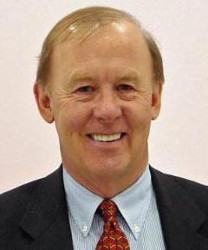
Jay Gronlund, president, The Pathfinder Group
The surge behind this exploding Bernie phenomenon is fascinating for many reasons. It is certainly an indication of how divergent our society and politics have become, and this could even intensify in the future. It also shows the political potential of finding and concentrating on the most pronounced issues that frustrate younger people from all ethnic backgrounds, especially Hispanics. Interestingly, from a branding perspective, there are some revealing lessons from this unexpected success of the Bernie Sanders brand.
Click here to read the entire article How Hispanic Millennials Are Driving the Bernie Sanders Brand
Posted by Elena del Valle on September 2, 2015
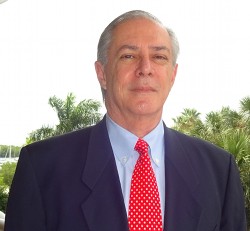
Ronald A. Lacayo, executive director, UTH Florida University
Photo: UTH Florida University
Targeting Spanish dominant immigrants from Central and South America looking to improve their economic prospects by completing their education with a college degree or obtain a second degree online in Spanish the Universidad Tecnologica de Honduras (UTH) is branching out. In August 2015, the owners of the Central American university and the Honduran-USA Chamber of Commerce announced the launch of UTH Florida University online.
Headquartered in Miami, Florida, UTH Florida University, a for profit entity, announced student registration in August 2015 and the beginning of classes September 1, 2015 at uthflorida.us. According to a press release distributed by UTH Florida University, the educational company is licensed by the Florida Commission for Independent Education. The Commission website indicates its functions include the licensure of independent schools, colleges and universities. All classes will be in Spanish and based on the Harvard Business School case method.
“We believe that on-line education is the disruptive innovation of the 21st century that will break the higher education paradigm and finally bring affordable and high quality education to everyone and everywhere thus allowing our communities and countries to grow and prosper,” said Ronald A. Lacayo, executive director, UTH Florida University.
Administrators plan to offer 16 classes in the Fall 2015 semester and 32 for Spring 2016 with the support of 10 staff. They expect the offerings to increase each semester.
“We expect 250 students enrolled by the end of 2016 and 500 by 2018,” said Lacayo by email. “Currently all of 80 faculty members are adjunct. Our staffing strategy is to seek maximum operating efficiency in order to pass along the savings to our students is the form of low and affordable tuition.”
The new company hopes to set itself apart from other distance educational institutions by offering students affordable undergraduate degrees for $9,600 in Business, Marketing and Human Resource Management. Graduate degrees in Management and International Business Administration, Business and Finance, and Business and Marketing will cost $5,880. According to the press release, the Universidad Tecnologica de Honduras which was founded in 1986 and has over 15,000 students.
Posted by Elena del Valle on April 21, 2014

Kristen Schiele, Ph.D., assistant marketing professor, Woodbury University
Photo: Kristen Schiele, Ph.D.
A podcast interview with Kristen Schiele, Ph.D., assistant marketing professor, Woodbury University, is available in the Podcast Section of Hispanic Marketing & Public Relations, HispanicMPR.com. During the podcast, she discusses how companies can utilize online reviews with Elena del Valle, host of the HispanicMPR.com podcast.
Kristen’s research focuses on Marketing Technology such as Online Review Analysis and Big Data Analytics, the Experience and Behaviors of Digital Consumers, and Consumer Culture. Prior to becoming an assistant professor at Woodbury University, she was an adjunct professor at California State University, Fullerton; California Polytechnic University of Pomona; and Vanguard University.
Kristen has over nine years of prior industry experience at The Irvine Company, Susan’s Healthy Gourmet, and as an independent marketing consultant. She is the former chief marketing officer of Fit for Green.
To listen to the interview, scroll down until you see “Podcast” on the right hand side, then select “HMPR Kristen Schiele, Ph.D.” and click on the play button below or download the MP3 file to your iPod or MP3 player to listen on the go, in your car or at home. To download it, click on the arrow of the recording you wish to copy and save it to disk. The podcast will remain listed in the April 2014 section of the podcast archive.
Posted by Elena del Valle on August 15, 2011
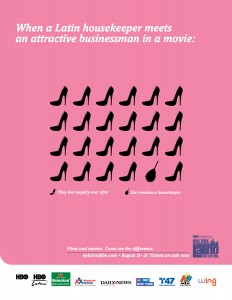
NYILFF Wing 2011 ad – click to enlarge
Photos, video: Wing
Hoping to attract English speaking New York City residents between 25 and 45 years of age to its twelfth annual event the organizers of the 2011 New York International Latino Film Festival (NYILFF) launched a new ad campaign the first week of August created to highlight a difference between movies and films by ribbing Hollywood movie cliches. The campaign with an estimated $50,000 in production costs and as much as one million dollars in paid and pro bono placements, was shot in Argentina with post production work in the United States. Scroll down to watch an ad.
The campaign emphasizes the shortage of Latinos in mainstream movies as well as the idea that Latino films concentrate on life compared to the “larger than life” abundant in blockbusters by showcasing stereotypical concepts like: The number of shots a six-round revolver can take in a movie without reloading, what happens in movies when a Latina housekeeper meets an attractive businessman, the names of gardeners in movies, and what happens in horror movies when a girl tries to get in a car.
TV and in-cinema ads, titled Asteroid, Dynamite, Fruit Stand Guy and Man in the Mirror, were produced by Wing, a New York ad agency, on a pro bono basis with the help of Academy Award winning Argentinean Production Company Puenzo Hermanos. The film festival staff believe the event’s audience consume a variety of media and love New York “for its energy and for everything it has to offer” and “define themselves as adventure-seekers and search out new and interesting experiences to fill their social calendar.”
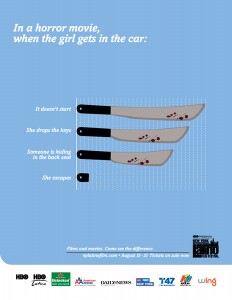
NYILFF Wing 2011 ad – click to enlarge
Each spot in the 2011 campaign makes fun of stereotypical Hollywood movie characters and ideas, and includes the tagline “Films and movies. Come see the difference.” In addition to TV, there are eight print and out-of-home ads in English and Spanish. The campaign seeks to reach “a broader audience with a commentary on the simplistic nature of Hollywood films, rather than an overtly Hispanic approach,” according to promotional materials.
Wing also created agency promotional material in-cinema and print that encourages people to let their Latino out. The in-cinema spot, intended to be “a whimsical and light-hearted effort” that shows an “un-Latin looking thin man” growing a thick mustache and liking it, attempts to emphasize the Hispanic influence on the mainstream market. Fifteen staff, led by Cionin Lorenzo, Elizabeth Gardner, Calixto Chinchilla, dedicated six months to the campaign production the success of which will be measured through ticket sales and on-line views. Festival staff anticipate 25,000 attendees at this year’s events.
The campaign was launched in NBC/Telemundo, HBO, Time, Out New York, Latina Magazine and the New York Daily News. In addition to the ads, the festival has active Facebook and Twitter pages where the new ads have been heavily promoted, a spokesperson indicated when asked about online placement of the ad campaign. The festival website was revised to coincide with the look and feel of the campaign. Also, the film festival independently created banner ads with geo-targeted placement on Hispanic websites. No information was available on which sites exactly.
The New York International Latino Film Festival strives to showcase the works of emerging Latino filmmakers in the United States and Latin America. This year’s festival run August 15-21 in various New York City theaters.
Posted by Elena del Valle on December 6, 2010

A scene from the PSA
Photos, video: Adrenalina
Compared to parents of other racial and ethnic groups Hispanic parents are less likely to talk with their children about the risks of drug and alcohol use. About 88 percent of Latino parents talk with their children while 94 percent of African American and 92 percent of Caucasian parents do, according to a 2008 Partnership Attitude Tracking Study. Among the 35 million families in the country with children ages 9-17, nearly 7 million Hispanic families with children in that age group are considered at risk for abusing drugs and alcohol, according to the Partnership at Drugfree.org.
Although in past years the Partnership at Drugfree.org has teamed up with several ad agencies to target Spanish speaking Americans, this year the non profit organization announced an Habla Con Tus Hijos (Talk with your Kids) ad; the first effort designed to build on the nonprofit organization’s Habla Con Tus Hijos initiative, a Spanish-language website and educational campaign aimed at encouraging parents to have frequent conversations with their kids about the risks of drug and alcohol use. Scroll down to watch the video in Spanish.
The series of 15- and 30-second TV and radio spots in Spanish developed by Adrenalina, a New York ad agency with Hispanic market capabilities, showcases a common neighborhood where everyone points to the neighbor’s kid as the source of local drug problems.
“Talking to your kids about drugs isn’t easy for any parent. The message of this campaign is that today it’s imperative,” said Victor Zeiris, creative director, Adrenalina. “This campaign addresses the problem of denial that’s prevalent in our communities. Two key themes of the creative work are to bring this issue to the forefront and to emphasize the importance of prevention.”
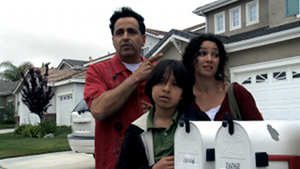
A scene from the PSA
El Hijo del Vecino (Spanish for the neighbor’s child) is meant to illustrate that kids are more exposed to drugs than their parents think and to encourage parents to take an active role protecting their children from drugs. The idea is to help them understand that a problem with the neighbor’s kid can easily become their own problem.
In the ads, the characters ignore what organizers believe is the obvious: that drugs in a community are everybody’s problem emphasizing “Asumir que es el problema de otros es el problema” (“Assuming that it’s somebody else’s problem, is the problem.”)
“We expect that this campaign will strike a chord with Hispanic parents who may not grasp that their kids are just as likely to be exposed to drugs as other people’s kids,” said Caryn Pace, deputy director of creative development, the Partnership at Drugfree.org, by email.
The Partnership began airing Spanish language public service announcements in the late 1990’s in print and broadcast. In 2009, the organization launched online resources for the Spanish-speaking community. Although initially there was a greater response with television messages, in 2010 marketers began to see high CTR’s (click-through-rates) for online ads leading to the continuation of its Hispanic digital program.
In 2009, the Partnership launched Habla Con Tus Hijos, its Spanish-language resource for parents and caregivers. The staff plans for 2011 include increasing the scale of content available to Spanish speakers and aligning with Hispanic partners in the public health and media fields to increase the reach of its message and content to target audiences.
“The Partnership at Drugfree.org reaches out to the Latino community in both Spanish and English. We are cognizant that there are many Hispanic parents whose first language is Spanish and therefore prefer to receive their information in that language. Demographically, there are millions of parents who identify as Hispanic/Latino and are fully acculturated, having been born/raised in the U.S., and prefer to receive health information in English,” said Roselena Martinez, marketing/communications manager, the Partnership at Drugfree.org, when asked about the organization’s outreach efforts to Latinos.
“As a result, we communicate with Hispanic parents in both English and Spanish, and our goal with our Spanish messaging is that it be more sensitive to culturally appropriate issues that predominantly Spanish-speaking parents may face, such as lack of understanding of American slang names for drugs, for example. The Spanish-speaking segment of our target audience(s) has responded positively in the past few years as we have created campaigns that are reaching out to Latino parents with cultural sensitivity, responding to real issues that Hispanic parents are facing that are often unique to them, when compared to other demographic groups.”
Eleven members of Adrenalina worked on the ad which was filmed in suburban Los Angeles. The target audience for this initiative is bicultural and less acculturated Spanish-dominant Hispanic parents 37-years-old, on average, with tweens and teens ages 9-14. The TV spots were directed by Simon Bross, with production work provided by Cortez Brothers, Los Angeles, and edited via Bross. Production work for the radio spots was provided by Mixology Lab, New York. All creative work by Adrenalina and its agency partners was produced pro bono. The Partnership at Drugfree.org is a nonprofit organization with a mission to help parents “prevent, intervene in and find treatment for drug and alcohol use by their children.”






















